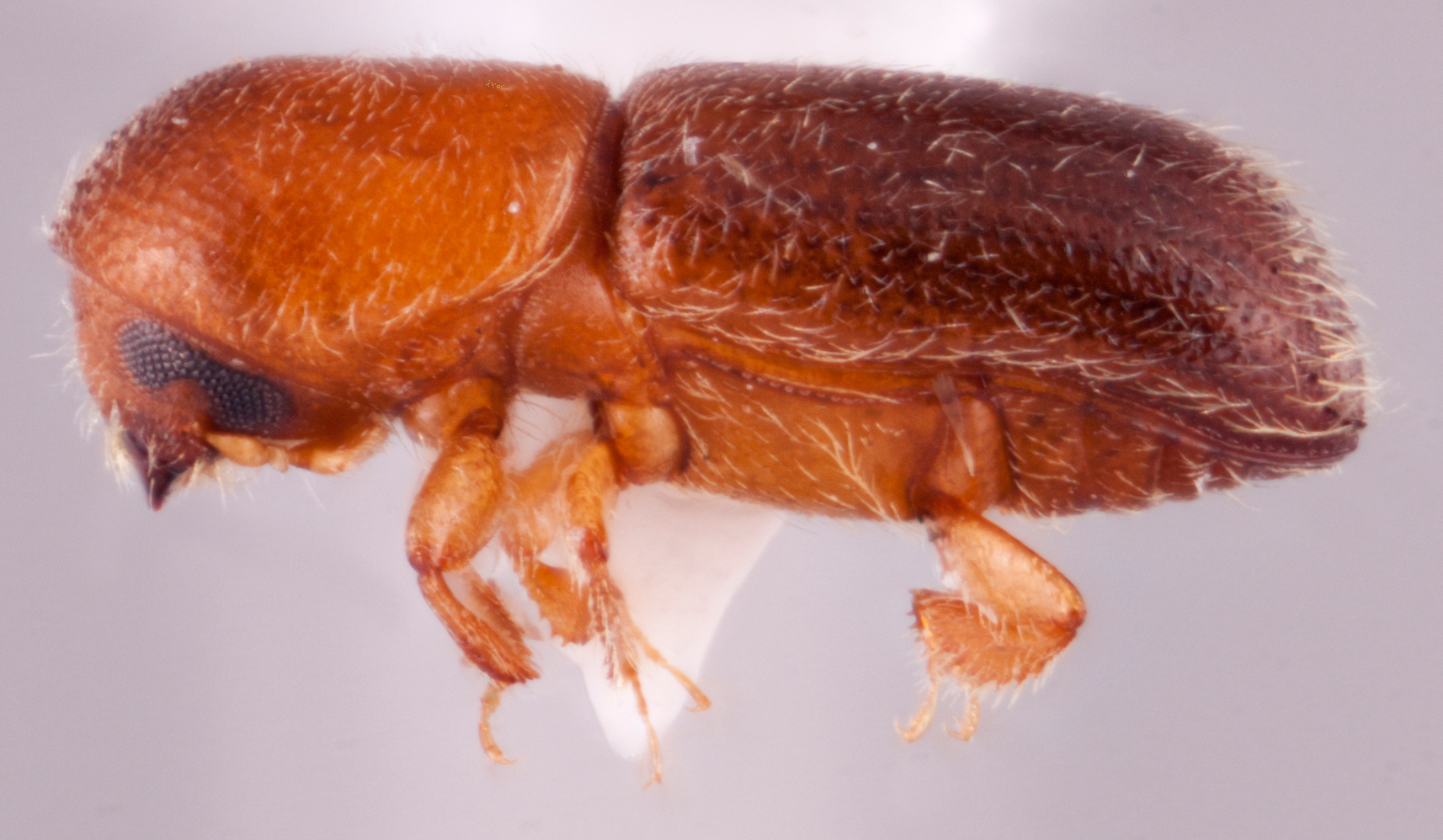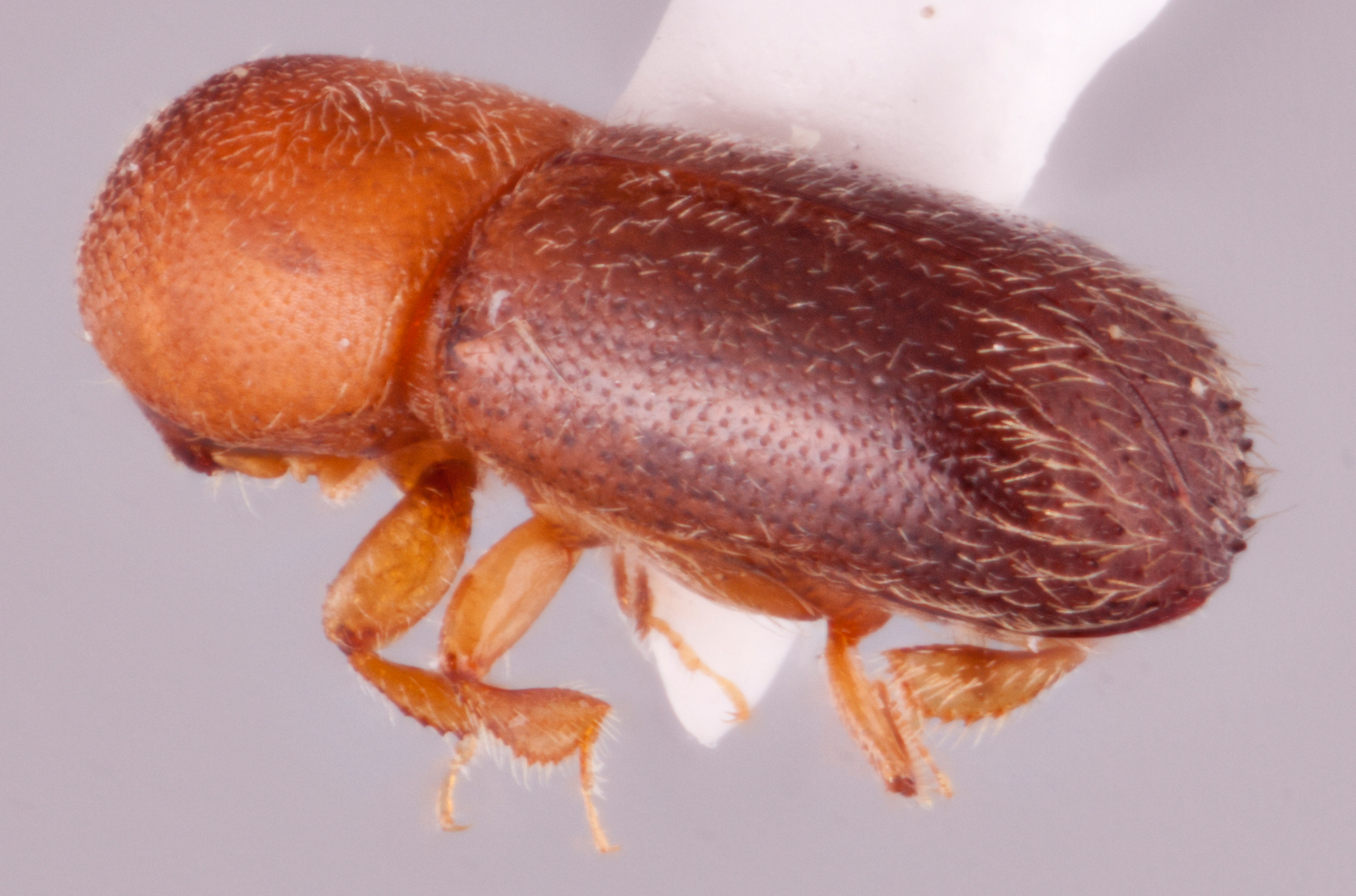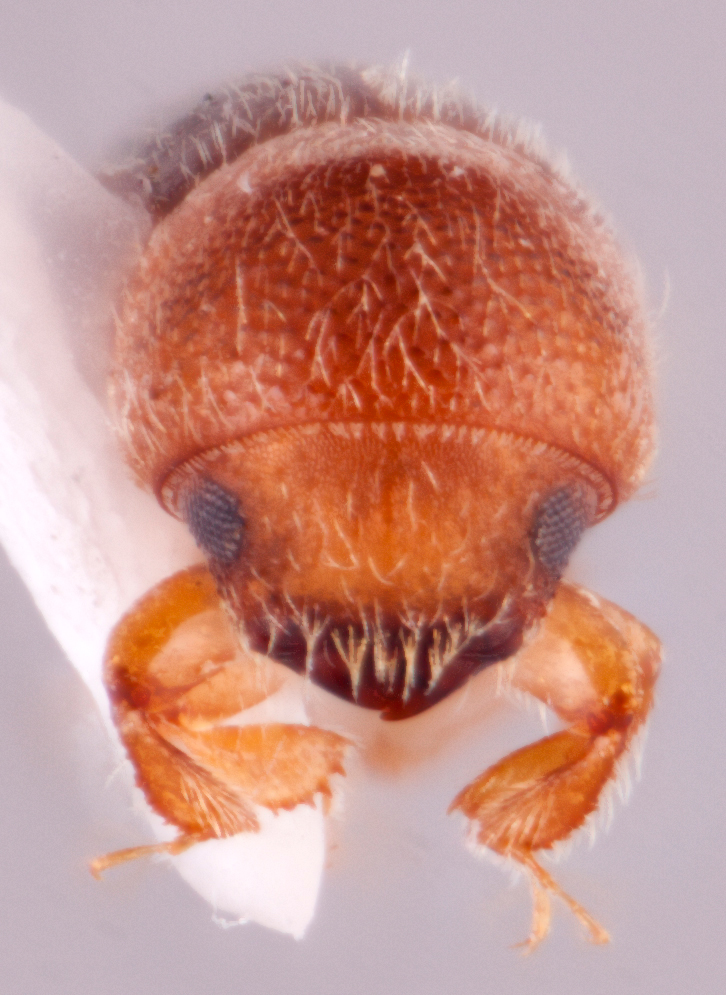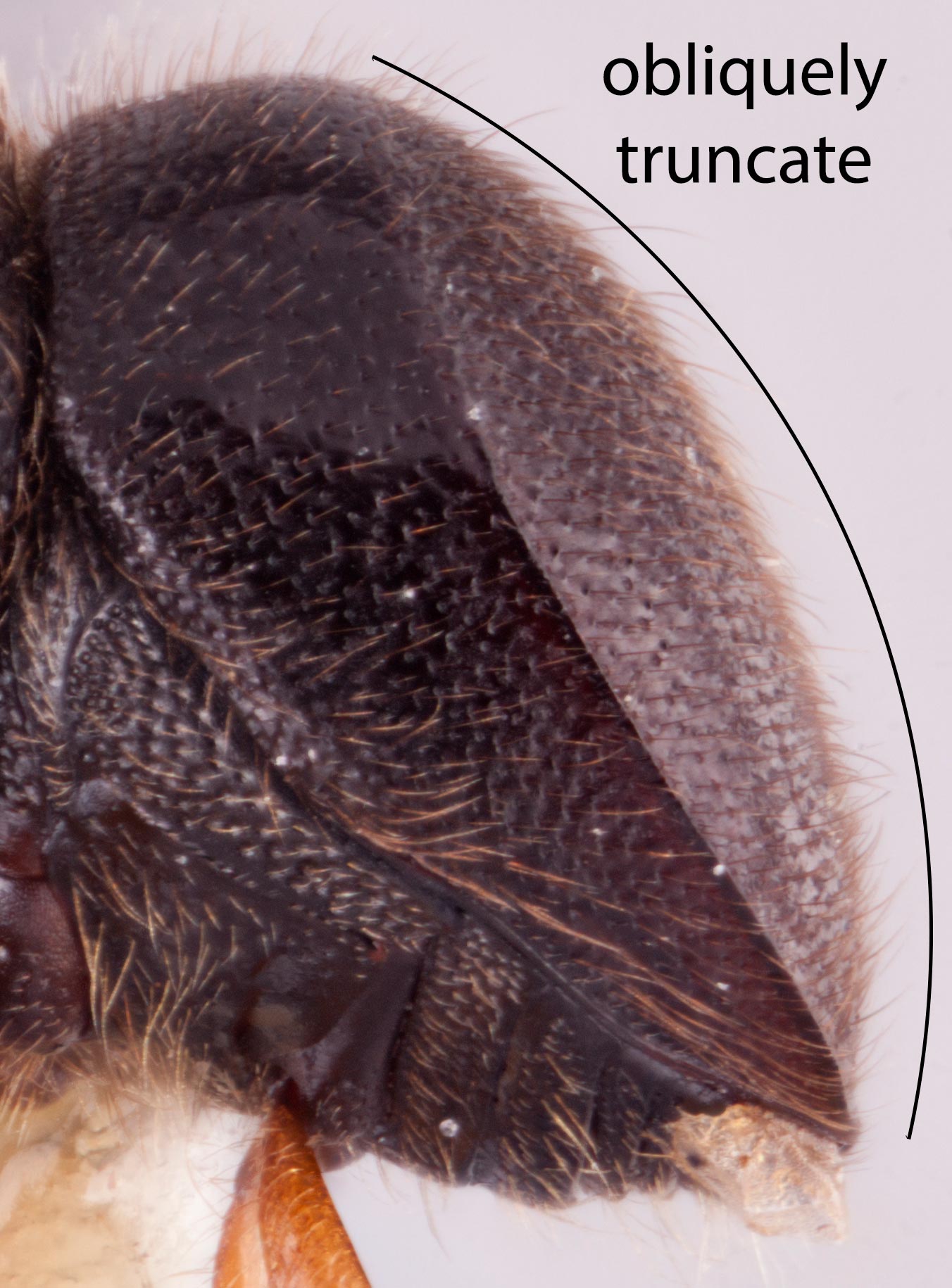Cyclorhipidion bodoanum
|
Cyclorhipidion bodoanum lateral; R.K. Osborn |
|
Cyclorhipidion bodoanum dorsal; R.K. Osborn |
|
Cyclorhipidion bodoanum declivity; R.K. Osborn |
|
Cyclorhipidion bodoanum frontal; R.K. Osborn |
Taxonomic history
Xyleborus bodoanus Reitter, 1913: 82.
Cyclorhipidion bodoanum (Reitter): Bussler and Immler 2007: 5; Mandelshtam and Petrov 2009: 216.
Synonyms
Xyleborus punctulatus Kurentzov, 1948: 52. Mandelshtam 2001: 203.
Xyleborus takinoyensis Murayama, 1953: 109: Smith et al. 2022b: 157.
Xyleborus misatoensis Nobuchi, 1981a: 146. Smith et al. 2020b: 182.
Diagnosis
1.7−2.2 mm long (mean = 2.03 mm; n = 4); 2.76−3.14 times as long as wide. This species is distinguished by the short, steep declivitydeclivity:
downward slope of either the pronotum or elytra
 that is approximately 25% of total elytralelytral:
that is approximately 25% of total elytralelytral:
pertaining to the elytra
length, armed with large tuberclestubercle:
a small knob-like or rounded protuberance of the exoskeleton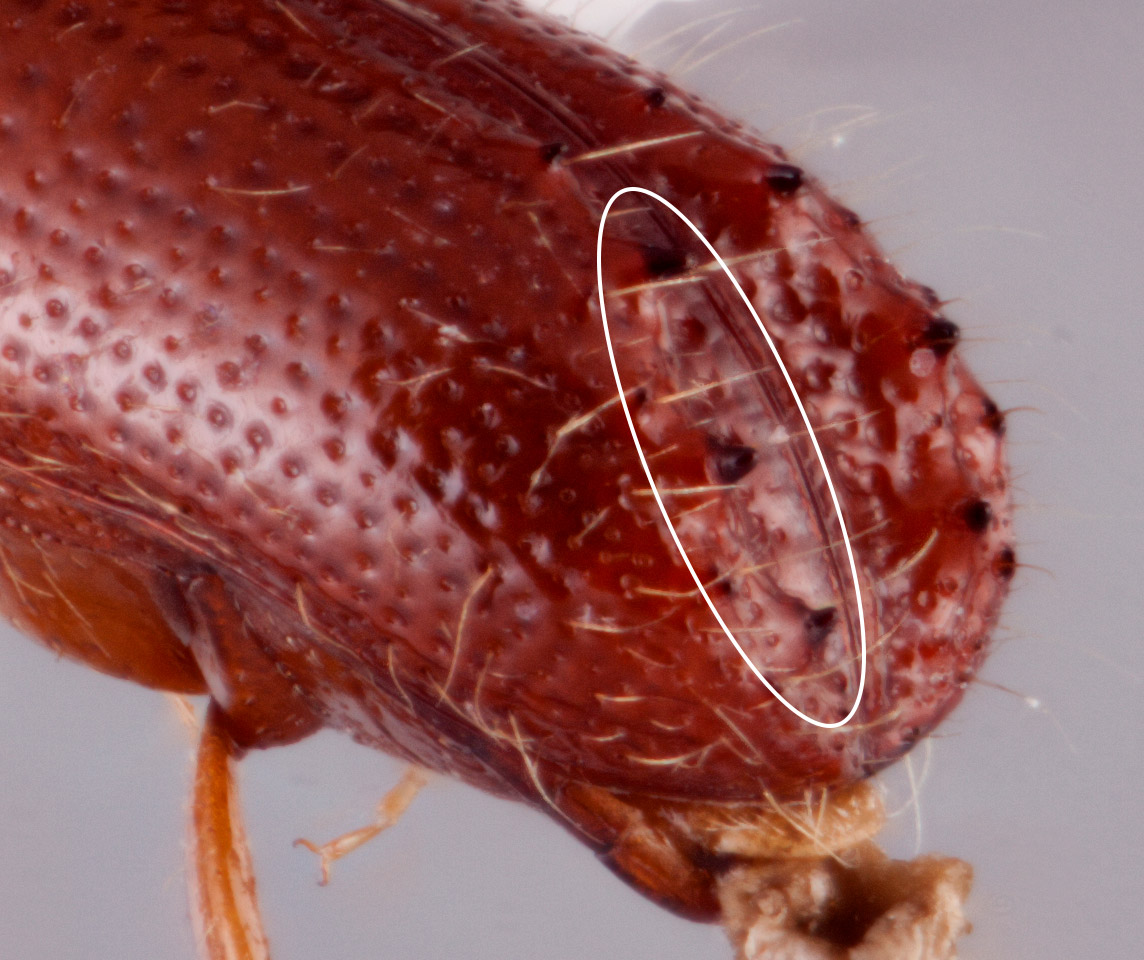 on interstriaeinterstria:
on interstriaeinterstria:
longitudinal spaces along the elytra between the striae, which is not as<br />
impressed and bear smaller punctures.
 1 and 3, interstriaeinterstria:
1 and 3, interstriaeinterstria:
longitudinal spaces along the elytra between the striae, which is not as<br />
impressed and bear smaller punctures.
 2 always unarmed; posterolateralposterolateral:
2 always unarmed; posterolateralposterolateral:
relating to end of the side part/portion
 margins rounded; and declivitaldeclivital:
margins rounded; and declivitaldeclivital:
pertaining to the elytral declivity
interstriae 1 and 2 setaeseta:
small hair-like or scale-like structure
uniseriate.
May be confused with
This species is a part of the challenging C. pelliculosum species group. Species in the group are most easily distinguished by the rows of setaeseta:
small hair-like or scale-like structure
along declivitaldeclivital:
pertaining to the elytral declivity
interstriae 1and 2. See table below:
|
species |
declivital declivital: |
declivital declivital: |
total body length (mm) |
total body length/width ratio |
lateral lateral: |
interstriae 2 granules |
interstriae 1 & 3 granules |
|
C. achlys Smith, Beaver and Cognato, 2022 |
3 |
1 |
3.4 |
3.09 |
steeply rounded |
absent |
present |
|
C. beaveri Lin and Smith, 2022 |
1 |
1 |
1.68−1.85 |
2.91−3.05 |
steeply rounded |
present |
present |
|
C. bodoanum |
2 |
1 |
1.6−2.4 |
2.5−3.29 |
steeply rounded |
absent |
present |
|
2 |
2 |
2.2 |
3.14 |
steeply rounded |
absent |
present |
|
|
C. cognatoi Lin and Smith, 2022 |
2 |
1 |
2.95−3.28 |
2.82−2.93 |
steeply rounded |
absent |
present |
|
3 |
2 |
2.5−3.11 |
2.6−3.0 |
steeply rounded |
absent |
present |
|
|
2 |
1 |
2.75−3.0 |
2.75−3.0 |
steeply rounded |
absent |
present |
|
|
1 |
1 |
2−2.2 |
2.75−3.07 |
steeply rounded |
absent |
present |
|
|
3 |
1 |
3.2−3.5 |
2.67−3.0 |
steeply rounded |
rare, on basalbase: |
present |
|
|
C. taedulum Smith, Beaver, and Cognato, 2022 |
2 |
1 |
2.7 |
3 |
steeply rounded |
absent |
present |
|
2 |
2 |
2.7−3.0 |
2.5−3.0 |
steeply rounded |
Often on apicalapex: |
present |
|
|
2 |
1 |
2.92−3.47 |
2.78 |
steeply rounded |
absent |
absent |
|
|
1 |
1 |
1.65−1.8 |
3.09−3.4 |
obliquely truncateobliquely truncate: |
absent |
present |
This species most closely resembles C. californicum, C. cognatoi Lin and Smith, 2022, C. inarmatum, C. nemesis, and C. xeniolum.
Distribution
China (Fujian, Heilongjiang, Hong Kong, Guizhou, Jiangxi, Yunnan), Japan, Laos, South & North Korea, Russia (Far East), Taiwan, Thailand, Vietnam. Introduced to Europe, USA (Wood 1975; Vandenberg et al. 2000Vandenberg et al. 2000:
Vandenberg NJ, Rabaglia RJ, Bright DE. 2000. New records of two Xyleborus (Coleoptera: Scolytidae) in North America. Proceedings of the Entomological Society of Washington 102: 62-68.; Kirkendall and Faccoli 2010Kirkendall and Faccoli 2010:
Kirkendall LR, Faccoli M. 2010. Bark beetles and pinhole borers (Curculionidae, Scolytinae, Platypodinae) alien to Europe. ZooKeys 56: 227-251. https://doi.org/10.3897/zookeys.56.529; Gomez et al. 2018aGomez et al. 2018a:
Gomez DF, Rabaglia RJ, Fairbanks KEO, Hulcr J. 2018a. North American Xyleborini north of Mexico: a review and key to genera and species (Coleoptera, Curculionidae, Scolytinae). ZooKeys 768: 19-68. https://doi.org/10.3897/zookeys.768.24697, Smith and Cognato 2022Smith and Cognato 2022:
Smith SM, Cognato AI. 2022. New exotic beetles found in the United States among pseudocryptic Cyclorhipidion species (Coleoptera: Curculionidae: Scolytinae: Xyleborini) revealed via a multigene phylogeny. Insect Systematics and Diversity Insect Systematics and Diversity 6(4), 2. https://doi.org/10.1093/isd/ixac014).
Host plants
Like a number of other species of Cyclorhipidion, the species has a clear preference for trees in the family Fagaceae, and most records are from Quercus, with rare attacks on Castanea (Bussler and Immler 2007Bussler and Immler 2007:
Bussler H, Immler T. 2007. Neue Borkenkauml;ferarten in Bayern. Forstschutz Aktuell 38: 5-8.). Also recorded from Pinus (Pinaceae) and Populus (Salicaceae) (Lightle et al. 2007Lightle et al. 2007:
Lightle DM, Gandhi KJK, Cognato AI, Mosley BJ, Nielsen DG, Herms DA. 2007. New reports of exotic and native ambrosia and bark beetle species (Coleoptera: Curculionidae: Scolytinae) from Ohio. The Great Lakes Entomologist 40: 194-200.).
Remarks
McPherson et al. (2008) note that the species attacks Quercus previously attacked by pathogenic fungi, resulting in the spread of decay fungi and increased tree mortality.
DNA data
Sequences available for COI and CAD.
COI: GU808697; MN619885; NC_036295; OM866991; OM866999; OM867006; OM867008; OM867009; OM867010

